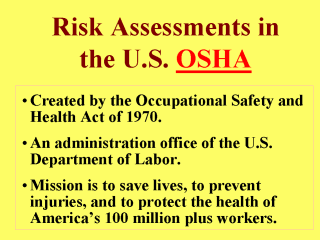| front |1 |2 |3 |4 |5 |6 |7 |8 |9 |10 |11 |12 |13 |14 |15 |16 |17 |18 |19 |20 |21 |22 |23 |24 |25 |review |
 |
Created by the
Occupational Safety and Health Act of 1970, the Occupational Safety and Health
Administration (OSHA) is part of the U.S. Department of Labor, with a mission to save
lives, to prevent injuries, and to protect the health of America’s more than 100 million
workers. OSHA’s most controversial health and safety standards have been exposure limits for toxic chemicals present in the workplace. In its early years, OSHA rejected the use of health risk assessment (RA) for occupational carcinogens or toxic chemicals in part because it believed the 1970 Act did not permit the use of such a quantitative process. Yet one important impetus to the adoption of RA as a decision-making tool by many regulatory agencies, including especially OSHA, was the U.S. Supreme Court’s decision on OSHA’s standard for worker exposure to benzene (National Research Council, 1994). That decision implicitly, if not explicitly, argued for some form of RA as a prelude to determining whether a risk was great enough to merit regulatory action. The 1970 Act also established NIOSH (Slide 13) to serve as an independent arm of OSHA for gathering data to set exposure limits for toxic substances present in the workplace. This legislative commitment has led NIOSH to conduct a good number of epidemiologic studies. And OSHA has since conducted RA for several chemicals and pathogens, including asbestos, methylene chloride, 4,4-methylenedianiline, 1,3-butadiene, and bloodborne pathogens. That for methylene chloride was based on an innovative PB-PK model (Lecture 1) incorporating animal and human metabolic information. |